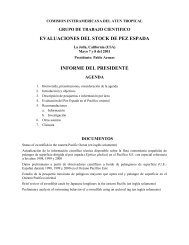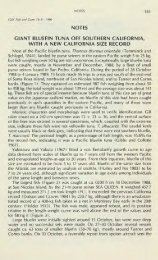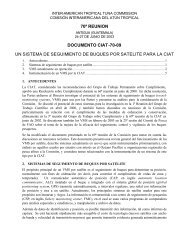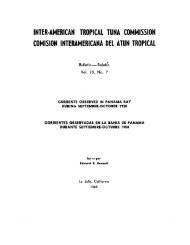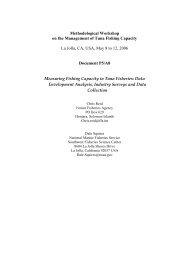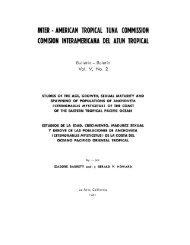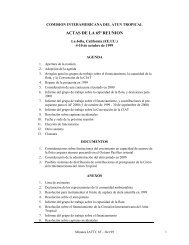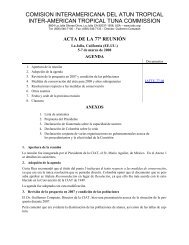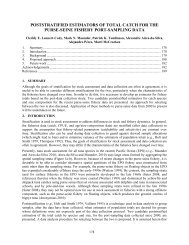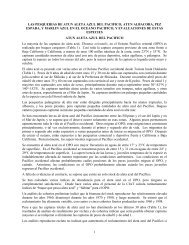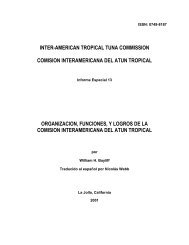INTER-AMERICAN TROPICAL TUNA COMMISSION - Comisión ...
INTER-AMERICAN TROPICAL TUNA COMMISSION - Comisión ...
INTER-AMERICAN TROPICAL TUNA COMMISSION - Comisión ...
- No tags were found...
Create successful ePaper yourself
Turn your PDF publications into a flip-book with our unique Google optimized e-Paper software.
B. YELLOWFIN <strong>TUNA</strong>An integrated statistical age-structured stock assessment model (Stock Synthesis Version 3) was used in the assessment, which isbased on the assumption that there is a single stock of yellowfin in the EPO. This model differs from that used in previous assessments.Yellowfin are distributed across the Pacific Ocean, but the bulk of the catch is made in the eastern and western regions. Thepurse-seine catches of yellowfin are relatively low in the vicinity of the western boundary of the EPO. The movements of taggedyellowfin are generally over hundreds, rather than thousands, of kilometers, and exchange between the eastern and western PacificOcean appears to be limited. This is consistent with the fact that longline catch-per-unit-of-effort (CPUE) trends differ among areas.It is likely that there is a continuous stock throughout the Pacific Ocean, with exchange of individuals at a local level, although thereis some genetic evidence for local isolation. Movement rates between the EPO and the western Pacific cannot be estimated withcurrently-available tagging data.The stock assessment requires substantial amounts of information, including data on retained catches, discards, indices of abundance,and the size compositions of the catches of the various fisheries. Assumptions have been made about processes such asgrowth, recruitment, movement, natural mortality, fishing mortality, and stock structure. The assessment for 2009 differs substantiallyfrom that of 2008 because it uses the Stock Synthesis program. Previous assessments have used the A-SCALA program. Themain differences include: use of a sex-specific model, inclusion of indices of abundance rather than effort, and use of functionalforms for selectivity. The catch and length-frequency data for the surface fisheries have been updated to include new data for 2008.New or updated longline catch data are available for China (2007), Chinese Taipei (2005-2007) and Japan (2003-2007). The catchesare shown in Figure B-1.In general, the recruitment of yellowfin to the fisheries in the EPO is variable, with a seasonal component (Figure B-2). This analysisand previous analyses have indicated that the yellowfin population has experienced two, or possibly three, different recruitmentproductivity regimes (1975-1982, 1983-2002, and 2003-2006). The productivity regimes correspond to regimes in biomass, higherproductivityregimes producing greater biomass levels. A stock-recruitment relationship is also supported by the data from theseregimes, but the evidence is weak, and is probably an artifact of the apparent regime shifts. Larger recruitments in 2007 and 2008have caused the biomass to increase in recent years.The average weights of yellowfin taken from the fishery have been fairly consistent over time, but vary substantially among thedifferent fisheries. In general, the floating-object, northern unassociated, and pole-and-line fisheries capture younger, smaller yellowfinthan do the southern unassociated, dolphin-associated and longline fisheries. The longline fisheries and the dolphinassociatedfishery in the southern region capture older, larger yellowfin than do the northern and coastal dolphin-associated fisheries.Significant levels of fishing mortality have been estimated for the yellowfin fishery in the EPO (Figure B-3). These levels are highestfor middle-aged yellowfin. Despite more catch being taken in schools associated with dolphins than the other fisheries, the floatingobject and purse seine sets on unassociated schools have a greater impact on the yellowfin spawning biomass (Figure B-4).The estimated biomass is significantly lower than estimated in the previous assessment indicating that the results are sensitive to thechanges in assessment methodology. There is also a large retrospective pattern of overestimating recent recruitment, due to the floating-objectsize composition data. These, in combination with the large confidence intervals for estimates of recent recruitment, indicatethat estimates of recent recruitment and recent biomass are uncertain. The results of the assessment are also particularly sensitiveto the level of natural mortality assumed for adult yellowfin.Historically, the spawning biomass ratio (SBR) of yellowfin in the EPO was below the level corresponding to the maximum sustainableyield (MSY) during the lower productivity regime of 1975-1983 (Section 4.2.1), but above that level for most of the followingyears, except for the recent period (2004-2007) (Figure B-5). The 1984 increase in the SBR is attributed to the regime change, andthe recent decrease may be a reversion to an intermediate productivity regime. The two different productivity regimes may supporttwo different MSY levels and associated SBR levels. The SBR at the start of 2009 is estimated to be above the level correspondingto the MSY. The effort levels are estimated to be less than those that would support the MSY (based on the current distribution ofeffort among the different fisheries) (Figure B-8), but recent catches are substantially below MSY (Table B-1).It is important to note that the curve relating the average sustainable yield to the long-term fishing mortality is very flat around theMSY level (Figure B-9). Therefore, changes in the long-term levels of effort will change the long-term catches only marginally,while changing the biomass considerably. Reducing fishing mortality below the level at MSY would provide only a marginal decreasein the long-term average yield, with the benefit of a relatively large increase in the spawning biomass. In addition, fishing atlevels corresponding to the MSY estimated from the base case, which assumes that recruitment is independent of spawning biomass,63



